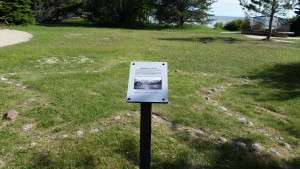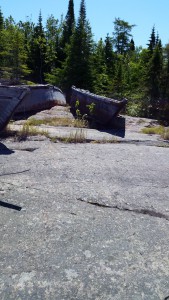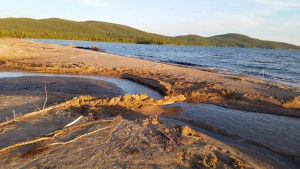Following a great trip to Pukaskwa National Park I kept up the natural history and camping adventure by spending a few nights at Neys Provincial Park. I was struck by the difference in landscape between the two parks despite them being less than an hour away from each other. Pukaskwa had very hilly, cliff views of Lake Superior and the shoreline was a rugged . In comparison Ney’s had long open beach shorelines, sand dunes, and forested areas.
Prisoner of War Camp

Prior to becoming a provincial park the land now encompassed by Neys was used as a Prisoner of War Camp known as Neys 100 during the second world war. The camp housed high ranking German officers and others and was primarily staffed by veterans from the First World War. There are bits of this history scattered throughout the present day park — building foundations, bits of embed stone, and other physical remnants are all interpretation points in the Park today. Additionally the physical landscape was fundamentally changed by the POW camp, they flattened sand dunes and used many of the trees for lumber. Trees were later replanted by the Boy Scouts but in standard plantation rows, leaving evidence of how the land has changed.
Point Trail

We didn’t do nearly as much hiking at Neys as at Pukaskwa, but I did manage to explore a couple of the trails. The Point Trail is a short 1 km trail that follows the shore of Lake Superior and ends at a rocky outcrop known as Prisoners’ Point. The trail then connects to the Under the Volcano Trail that explores the shoreline stretching from the Point. I explored a bit of this trail as well. The trail was a relatively easy walk, albeit a bit wet when I walked it and it was well worth the puddle jumping to reach the views of the lake at the end. There was a few interpretive signs but they were relatively sparse. I did enjoy the one that talked about the remains of old boats located on the point– the boats were left over from the Prisoner of War camp era and the logging days of the region.
Dune Trail
This easy loop hike included an interpretive handout that visitors could take with them on the walk. The handout included numbers which matched specific points on the trail and provided interpretive details about that area. The handout included a bit of information about the role of the POW camp on the landscape but primarily focused on flowers, the dunes, trees, and the impact of local animal life on the landscape. Unsurprisingly, I liked the fact that there was a physical thing to hold during the walk and that the interpretation was a bit more developed on this trail.
Visitors’ Centre

The Visitors’ Centre was only open during the last day I was at the park. Despite this we managed to make a short visit to the Centre and check out some their primary interpretive space. The displays were fairly standard for a provincial park, a lot of focus on the natural landscape with most material geared at families and including a number of touch and feel stations focused on children. There was also a substantial section dedicated to the history of Neys 100 which included a model which demonstrated what the POW camp would have looked like. The staff at the Centre were very friendly and seemed to know a lot about the history of the Park and were happy to answer questions about the way the landscape had changed.
